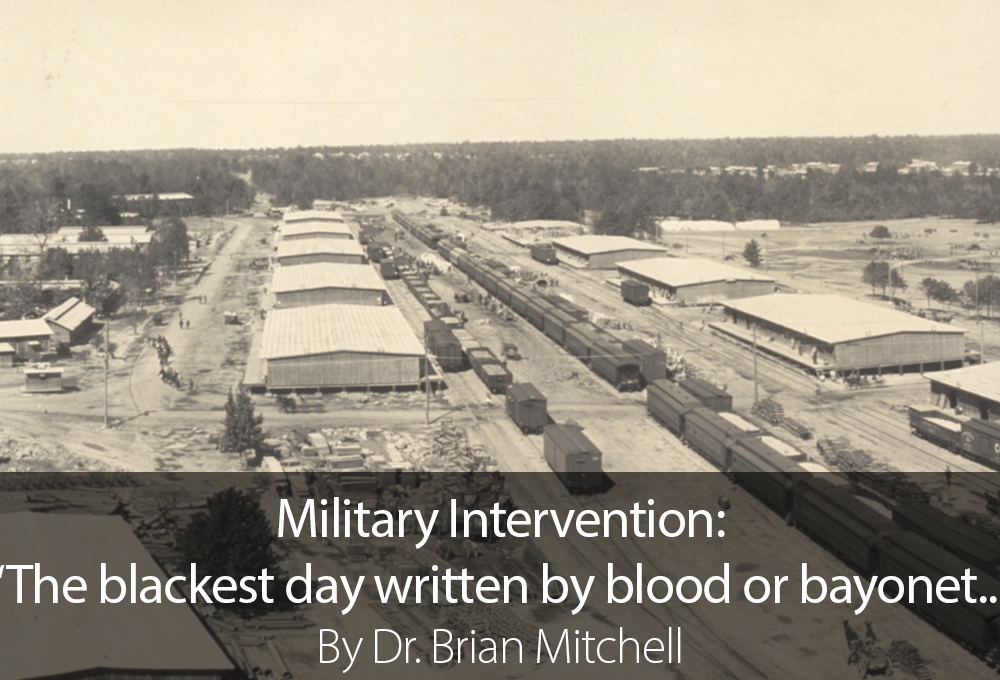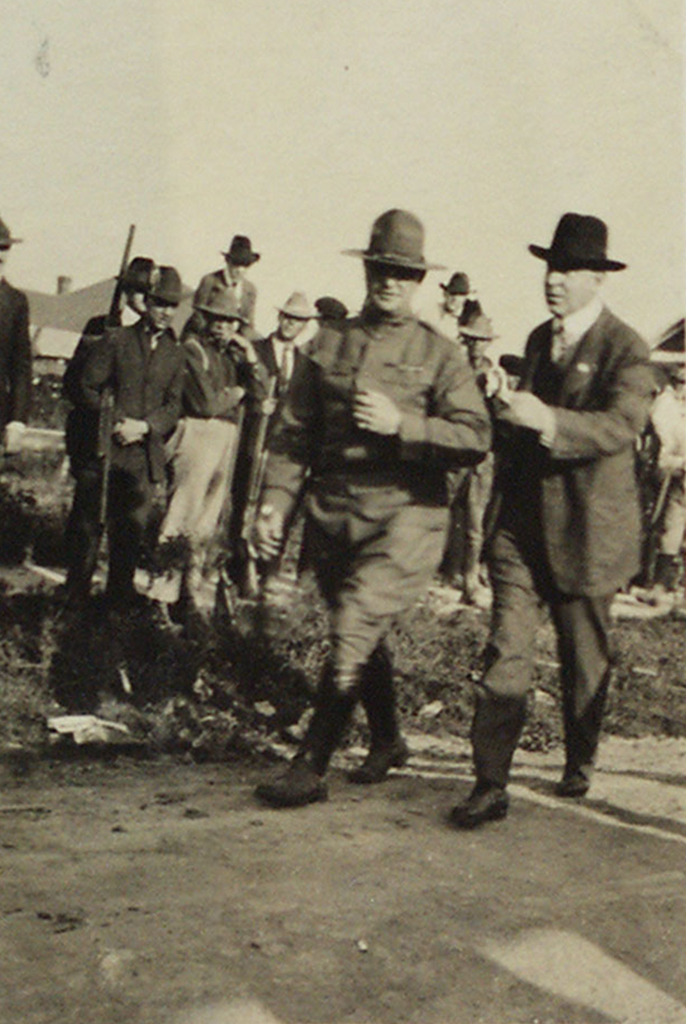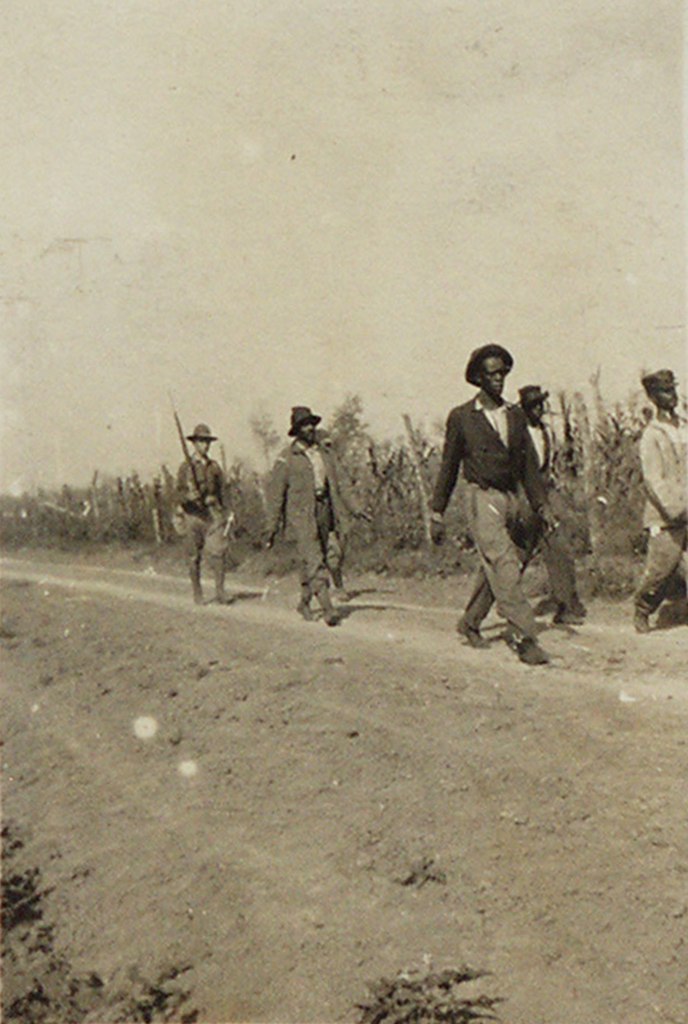When panicked messages of an ongoing race war reached Governor Charles H. Brough, he quickly notified Major General S. D. Sturgis, the commanding officer of the nearby army encampment, Camp Pike. Sturgis had no authority to commit his soldiers to intervene within the state, so Brough was advised to contact the secretary of war. By October 2, 1919, with the intervention of both of Arkansas’s U.S. senators, Brough secured orders for 583 soldiers from the Third Division and the Fifty-Seventh Infantry to accompany him to Phillips County. The provisions of Special Order 264 maintained that “By direction of the President, a detachment of troops consisting of four rifle companies of the Third Division, two rifle companies of the 57th Infantry, under command of Colonel Isaac Jenks, Infantry, 3rd Division, will proceed from Camp Pike, Ark., to Elaine, Arkansas, for the purpose of quelling disorders and protecting lives and property.”
An advance order dated October 1, 1919, divided the troops into four provisional companies and noted that soldiers assigned to the engagement would show up with “full field equipment ready to move out in short notice. The soldiers traveled by train from Camp Pike to Elaine, arriving in the town at 8:15 a.m. on October 2, 1919. Colonel Jenks reported that upon his arrival he found the town in “a great state of excitement” with “hundreds of white men, all carrying fire-arms” on the streets, “near the station and in groups, all over town.”
Jenks sent one of his provisional companies under the command of Major Callen to secure the area around the town. The company advanced about a mile and a half when it found they “a negro woman lying in front of her doorstep and barely alive, shot through the neck several hours before.” While Jenks’s report failed to provide the name of the victim, Ida B. Wells’s The Arkansas Race Riot identified her as Frances Hall, a mentally ill housekeeper and relative of two PFHUA members, Frank and Paul Hall. After finding the body, Jenks reported that the battalion reconnoitered approximately two miles of the surrounding terrain. The report described the search for the alleged black rebels, noting only that they had “captured several prisoners” and “all the rest of the colored outlaws had disappeared.” During the engagement there was one soldier killed, Corporal Luther Earles and another wounded, Sergeant Pearl B. Gay, as the troops searched the countryside. Both soldiers were shot in a clearing as they approached dense thickets. The marksman responsible shot from the cover of an “impregnable” forest and although no one could identify the marksman in the bush, a local sharecropper, Sam Wilson, was charged with Earles’s murder. Wilson pled guilty to second-degree murder on November 7, 1919, and was sentenced to twenty-one years in prison.
Soldiers took hundreds of black sharecroppers into custody. The captured farmers were held in a commandeered school that had been made into a makeshift stockade. While in the army’s custody, captured blacks were interrogated in hopes of identifying members of the Progressive Farmers and Household Union of America (PFHUA). Those who proved to have no connection to the union were released, given passes for safe passage, and were ordered to return to work in the fields. The troops remained in Phillips county until October 7, 1919. The role that the soldiers played in the massacre and whether or not they participated in the killing of black sharecroppers has been the focus of considerable debate since the event. Colonel Jenks’ report mentioned no participation on the part of soldiers in any of the atrocities that occurred in the county. The Colonel’s report was, however, contradicted by a number of sources. Among them was the account of Captain Edward P. Passailaigue of the Third Division’s Ammunition, an officer serving under Jenk’s command. In his account, Passailaigue reported that “to the best of my knowledge about twenty negroes were killed by soldiers for refusing to halt when so ordered or for resisting arrest.” Other accounts of the massacre maintained that the soldiers were responsible for the majority of deaths in the county. Louis Sharpe Dunaway, a writer for the Arkansas Gazette, described the arrival of the soldiers to Elaine as “the blackest day ever written by blood or bayonet in the history of Arkansas.” Dunaway claimed soldiers were to blame for the bulk of 856 blacks he maintained were killed during the massacre.
Header Image: Panoramic Photograph Collection, Library of Congress.
For More Information
Barnett, Ida B. Well. The Arkansas Race Riot. Chicago: Ida B. Well-Barnett, 1920.
Cortner, Richard C. A Mob Intent on Death: The NAACP and the Arkansas Riot Cases. Middletown, CT: Wesleyan University Press, 1988.
Desmarais, Ralph H. "Military Intelligence Reports on Arkansas Riots: 1919-1920." Arkansas Historical Quarterly 33, no. 2 (1974): 175-91.
Dunaway, Louis Sharpe. What a Preacher Saw through a Keyhole in Arkansas. Little Rock: Parke-Harper Publishing, 1925.
Ferguson, Bessie. “The Elaine Race Riot.” MA thesis, George Peabody College for Teachers (now Peabody College of Education and Human Development at Vanderbilt University), 1927.
Finley, Randy. "Black Arkansans and World War One." Arkansas Historical Quarterly 49, no. 3 (1990): 249-77.
House, Roger. Blue Smoke: The Recorded Journey of Big Bill Broonzy. Baton Rouge: Louisiana State University Press, 2010.
Investigative Case Files of the Bureau of Investigation 1908 – 1922, Old German Files 1909-1921, RG65.
Lambert, Gerald B. All Out of Step: A Personal Chronicle. New York: Doubleday, 1956.
Lancaster, Guy. The Elaine Massacre and Arkansas: A Century of Atrocity and Resistance, 1819-1919. Little Rock: Butler Center Books, 2018.
Laurie, Clayton David , and Ronald H. Cole. The Role of Federal Military Forces in Domestic Disorders, 1877-1945. Washington, D.C.: Center of Military History, 1997.
Lewis, Todd E. "Mob Justice in the "American Congo": "Judge Lynch" in Arkansas during the Decade after World War I." Arkansas Historical Quarterly 52, no. 2 (1993): 156-84.
Military Intelligence Division-Negro Subversion, RG 165.
Records of the Adjutant General's Office, RG407.
Rogers, O. A. "The Elaine Race Riots of 1919." The Arkansas Historical Quarterly 19, no. 2 (1960): 142-50.
Stockley, Grif. Blood in Their Eyes: The Elaine Race Massacre of 1919. Fayetteville: University of Arkansas Press, 2004.
Stockley, Grif, and Jeannie M. Whayne. "Federal Troops and the Elaine Massacres: A Colloquy." Arkansas Historical Quarterly 61, no. 3 (2002): 272-83.
Whitaker, Robert. One the Laps of Gods: The Red Summer and the Struggle for Justice That Remade a Nation. New York: Crown Publishers, 2008.
Woodruff, Nan Elizabeth. American Congo: The African American Freedom Struggle in the Delta. Cambridge and London: Harvard University Press, 2003.
About the Author
Dr. Brian Mitchell is a professor of history at UA Little Rock. His interests include race and ethnicity, immigration, public history, and black history. He has spent considerable study on the Elaine Race Massacre. In 2018, his research earned Leroy Johnson, an Elaine victim and World War I veteran, to be posthumously awarded the Purple Heart and other military honors from his service.


